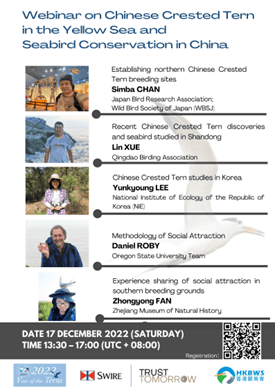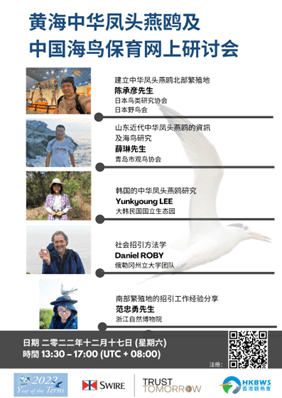
Chinese Crested Tern © Simba Chan
Listed as Critically Endangered on the IUCN’s Red List, the Chinese Crested Tern’s global population is estimated to be around 100-200 individuals. We call it the “bird of legend” as there were only a few sightings recorded in the past and it even disappeared from human sight from 1937 until 2000. In 2000, four pairs of Chinese Crested Tern were rediscovered on Matzu Island and subsequently conservationists started searching for and conserving the “bird of legend” in Fujian and Zhejiang
To save this rare species from extinction, experts across the region have been actively engaging in research and conservation over the years by drafting the single species action plan and initiating breeding colony restoration and satellite tracking studies.Chinese Crested Tern has been selected by East Asian-Australasian Flyway Partnership (EAAFP) as one of the feature species in the Year of the Terns 2022 campaign, as it needs to draw our attention for its long-term survival.
On 17th December, 2022, The Hong Kong Bird Watching Society organized a webinar titled “Chinese Crested Tern in the Yellow Sea and Seabird Conservation in China”, enlisting guest speakers from different countries to share their experiences and thoughts on Chinese Crested Tern and seabird conservation. 50 participants from 10
countries joined the webinar.
 |
 |
An increasing trend of Chinese Crested Terns in Qingdao was observed in recent years. Lin XUE, Chair of Qingdao Birding Association, explained that this could be due to the stable weather condition in Jiaozhou Bay, Qingdao, which is a desirable roosting and parenting site for Chinese Crested Tern colony. He also brought out the importance of exchanging information between sister organizations, as this can make local conservationists notice the roosting site of the Chinese Crested Tern as soon as possible.
Dr Yunkyoung LEE, Researcher at National Institute of Ecology of the Republic of Korea, shared the ongoing studies and findings of Chinese Crested Tern study in Korea, including the breeding cycle of Chinese Crested Tern, behaviour observation and interaction between Black-tailed Gull and Chinese Crested Tern, and individual identification of Chinese Crested Tern are also essential aspects for future studies and conservation.
Professor Daniel ROBY from Oregon State University, USA, shared the history of social attraction techniques and the experience of the Caspian Tern colonies’ restoration. He also pointed out that social attraction to restore tern colonies is highly successful under a few requirements, comprising selections of location, provision of suitable nesting substrate, installation of decoys and audio playback systems, etc.
The key breeding sites of Chinese Crested Tern are Matzu Island, the Penghu Islands, one site in the Republic of Korea, and two sites in Zhejiang currently. Mr Zhongyong FAN, Section In-Charge of Life Science Department of Zhejiang Museum of Natural History, shared the Chinese Crested Tern restoration through the adoption of social attraction techniques in Zhejiang. He also suggested that more new sites between the current sites, especially between Zhejiang and Fujian, can be established by adopting social attractions.
To conserve Chinese Crested Tern, Mr Simba CHAN stated the importance of restoration of the northern breeding population. For instance, the northern breeding ground can reduce the threats of bad weather like typhoons to the tern colony, and lower the chance of hybridization between Greater Crested Terns and Chinese Crested Terns as the northern population of Chinese Crested Tern formed the breeding colony with Black-tailed Gull instead of Greater Crested Tern in the south, and disease that could wipe out the whole breeding population if the birds breed only in one place.
Most of the speakers pointed out onsite monitoring is critical to tern restoration. During the breeding season, nesting seabirds face different threats which may lead to failure of nesting or abundance of the colony, such as terrestrial predators including rats and snakes feeding on their chicks and eggs. Human disturbance, especially egg collection, is also a serious threat to seabirds in China. The speakers agreed that onsite monitoring during the breeding season can detect and prevent potential problems affecting the breeding colony.

Group photo of the webinar © HKBWS
Followed by the experts’ sharing, a discussion forum was conducted for participants to provide comments and exchange thoughts on seabird conservation in China. It provided a platform for researchers and conservationists to update and share seabird conservation works and plans at their site, which enhanced collaborations and communications among partners on seabird conservation in China.
After the webinar, a seabird conservation focus group on WeChat was formed for partners to communicate with each other in long term and keep the momentum going on seabird conservation work.
Click here for the Webinar Review
Article prepared by Hong Kong Bird Watching Society.





